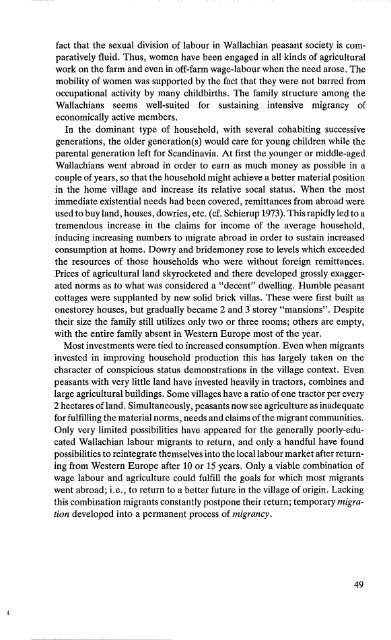Will they still be dancing? (1982)
Etnographic study of Romanians from East Serbia in Sweden in 1980s
Etnographic study of Romanians from East Serbia in Sweden in 1980s
You also want an ePaper? Increase the reach of your titles
YUMPU automatically turns print PDFs into web optimized ePapers that Google loves.
fact that the sexual division of labour in Wallachian peasant society is comparatively<br />
fluid. Thus, women have <strong>be</strong>en engaged in all kinds of agricultural<br />
work on the farm and even in off-farm wage-labour when the need arose. The<br />
mobility of women was supported by the fact that <strong>they</strong> were not barred from<br />
occupational activity by many childbirths. The family structure among the<br />
Wallachians seems well-suited for sustaining intensive migrancy of<br />
economically active mem<strong>be</strong>rs.<br />
In the dominant type of household, with several cohabiting successive<br />
generations, the older generation(s) would care for young children while the<br />
parental generation left for Scandinavia. At first the younger or middle-aged<br />
Wallachians went abroad in order to earn as much money as possible in a<br />
couple of years, so that the household might achieve a <strong>be</strong>tter material position<br />
in the home village and increase its relative socal status. When the most<br />
immediate existential needs had <strong>be</strong>en covered, remittances from abroad were<br />
used to buy land, houses, dowries, etc. (cf. Schierup 1973). This rapidly led to a<br />
tremendous increase in the claims for income of the average household,<br />
inducing increasing num<strong>be</strong>rs to migrate abroad in order to sustain increased<br />
consumption at home. Dowry and bridemoney rose to levels which exceeded<br />
the resources of those households who were without foreign remittances.<br />
Prices of agricultural land skyrocketed and there developed grossly exaggerated<br />
norms as to what was considered a "decent" dwelling. Humble peasant<br />
cottages were supplanted by new solid brick villas. These were first built as<br />
onestorey houses, but gradually <strong>be</strong>came 2 and 3 storey "mansions". Despite<br />
their size the family <strong>still</strong> utilizes only two or three rooms; others are empty,<br />
with the entire family absent in Western Europe most of the year.<br />
Most investments were tied to increased consumption. Even when migrants<br />
invested in improving household production this has largely taken on the<br />
character of conspicious status demonstrations in the village context. Even<br />
peasants with very little land have invested heavily in tractors, combines and<br />
large agricultural buildings. Some villages have a ratio of one tractor per every<br />
2 hectares of land. Simultaneously, peasants now see agriculture as inadequate<br />
for fulfilling the material norms, needs and claims ofthe migrant communities.<br />
Only very limited possibilities have appeared for the generally poorly-educated<br />
Wallachian labour migrants to return, and only a handful have found<br />
possibilities to reintegrate themselves into thelocal labour market after returning<br />
from Western Europe after 10 or 15 years. Only a viable combination of<br />
wage labour and agriculture could fulfill the goals for which most migrants<br />
went abroad; Le., to return to a <strong>be</strong>tter future in the village of origin. Lacking<br />
this combination migrants constantly postpone their return; temporary migration<br />
developed into a permanent process of migrancy.<br />
49<br />
4
















